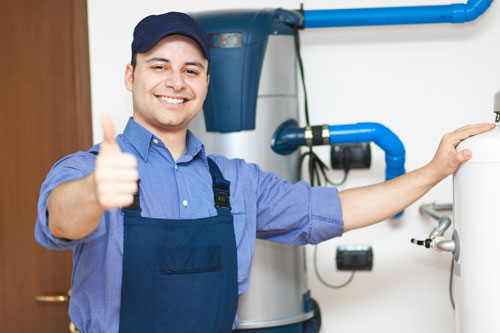
Are you not in hot water? With a little understanding you can take care of some problems yourself, and be better prepared to understand your options if it’s time for a professional water heater repair.
How Hot Water Heaters Work
A standard hot water heater, whether residential or commercial, is basically just a tank and a source of heat. When you turn on the faucet hot water comes from the tank and fresh cold water replenishes it. When the tank temperature falls below your setting (either from use or from gradual losses thorough the tank’s insulation) the heat source kicks in to warm things back up. But maybe not as fast as you’re using up what’s already nice and warm.
It’s the many details that often make troubleshooting and repair difficult.
Some are common to all regular models. Although both the inlet and outlet fittings are usually on the top of the tank a “dip tube” delivers the cold line to the tank’s bottom so that it doesn’t mix with the hot. A sacrificial anode protects the tank against corrosion by rusting away itself. There’s also a temperature and pressure relief valve for safety and a drain valve for flushing out sediment.
Electric water heaters are pretty straightforward with the addition of just two heating elements, a thermostat, and an over-temperature protection switch.
Gas water heaters on the other hand are more complex and therefore more difficult to diagnose and repair. The burner itself must provide just the right mixture of air and gas, and the exhaust flue must be unobstructed and without gaps. A thermostat opens a gas valve, and the burner must then be lit by an electronic ignition circuit or a pilot light. A thermo couple measures flame temperature and a controller prevent the gas from running if the pilot light is our or the burner doesn’t light.
When They Don’t Work: Symptoms and Repairs
Problems can include rust-colored or smelly water, but leaks along with not enough or no hot water are the most common reasons for water heater repair calls. Here’s a list of symptoms and the most likely culprits.
- No Hot Water. For electric units that could be a tripped circuit breaker or over-temperature safety (you can easily reset those yourself), a faulty thermostat, or both elements burning out. For gas units there are many possible causes. Is the pilot light burning? You can check this yourself and re-light it following the instructions printed on the unit itself or in the user’s manual. Otherwise the problem can be anywhere in the long chain from pilot/igniter to burner.
- Not Enough Hot Water. If there hasn’t been a reason for increased use (perhaps a visitor or a new appliance), the first thing to do is check that the thermostat hasn’t been accidentally set too low (setting it too high wastes energy and can lead to scalding). If the dip tube has corroded away, that could be your problem. Scale on the heating elements or heat exchanger as well as the build up of sediment may also leave you with an unsatisfying shower. Other than a faulty thermostat the next most likely alternative for electric models is that just one of the elements has burned out. For gas fueled models the burner is usually working well enough or not working at all.
- Leaks. Just about any of the valves and fittings could be leaking. You may see some drips or even spray, or just some rust or white-colored deposits. A leaking tank can be a bit trickier. Water collecting in the pan underneath are a dead giveaway, or you may notice some rust-colored streaks along the outside, particularly near the bottom and around any openings.
- Rusty water. This usually means that the protective anode is used up and the tank has corroded. Unfortunately that in turns means a replacement water heater installation.
- Smelly Water. The odor typically comes from bacteria growing on sediment inside the tank, calling for draining and sanitizing.
- Strange Sounds. Tapping noises aren’t unusual when the tank is quickly heating up or cooling down. Loud pops and thuds are usually the result of scaling breaking off to become sediment. A boiling sound is an emergency — it’s likely that the safety device limiting temperature and pressure has failed, leaving you at risk of a steam explosion.
[fusion_builder_container hundred_percent=”yes” overflow=”visible”][fusion_builder_row][fusion_builder_column type=”1_1″ background_position=”left top” background_color=”” border_size=”” border_color=”” border_style=”solid” spacing=”yes” background_image=”” background_repeat=”no-repeat” padding=”” margin_top=”0px” margin_bottom=”0px” class=”” id=”” animation_type=”” animation_speed=”0.3″ animation_direction=”left” hide_on_mobile=”no” center_content=”no” min_height=”none”][fusion_tagline_box backgroundcolor=”” shadow=”no” shadowopacity=”0.1″ border=”1px” bordercolor=”#666″ highlightposition=”left” link=”tel:7607448489″ linktarget=”_blank” buttoncolor=”blue” button=”(760) 744-8489″ title=”Have A Water Heater Emergency?” description=”Emergency Services and Same Day Appointments Available” animation_type=”0″ animation_direction=”down” animation_speed=”0.1″][/fusion_tagline_box]
When You Need a Professional
Most home and business owners can check a circuit breaker, over-temperature switch, or thermostat as well as re-light a pilot light. But if you hear those gurgling or boiling sounds or suspect a problem with leaking gas, evacuate the area and call a professional plumber immediately! In fact, not just any plumber. Only someone licensed as a master plumber (as many of our crew are) can work on gas lines. Do-it-yourselfers can find instructions on the web for flushing the tank (recommended as annual maintenance) as well as fixing leaks and other problems, but keep in mind that requires more than a little bit of skill with tools. A minor mistake can lead to an even more difficult and expensive problem. So call in a pro for anything you’re not completely comfortable with or simply don’t have the time for. Most people wisely choose professionals like those at ASAP Drain Guys & Plumbing for fast, reliable, going-to-last repairs.[/fusion_builder_column][/fusion_builder_row][/fusion_builder_container]

